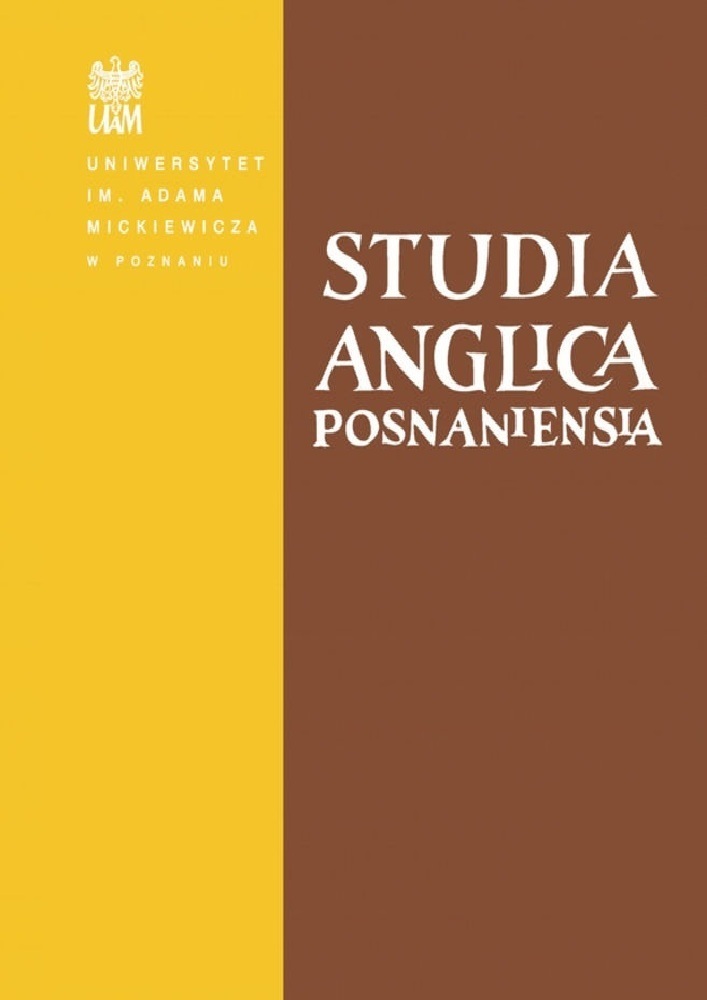Abstract
Human identity is shaped not only by culture, but also by nature – the environment in which people grow up and live, the places and spaces they visit, work in, and pass on an everyday basis. This people-place bond is particularly important in case of immigrants who are forced to abandon the places they know for a new – and often hostile – environment. This connection between space, environment, and immigrant identity is explored by Kerri Sakamoto, a Japanese-Canadian writer, in her newest novel, Floating City (2018). Focusing on the family narrative of the Hanesakas – and, in particular, the story of Frankie, the oldest son of the family – Sakamoto tells the story of shaping identity through forming a connection with the environment and architecture. The aim of this article is to discuss the way in which Sakamoto presents the people-place bond and its impact on immigrant identity as represented by the connection of the Japanese-Canadians with four elements: water, air, earth, and fire. Furthermore, the article analyses Sakamoto’s version of an alternative history of Toronto and the possible solutions to the current environmental crisis it brings. For this purpose, the author uses a mixture of methodological concepts stemming from postcolonial theory and environmental psychology, such as homing desire, rootlessness, place attachment, non-place, and the people-place bond.
References
Agnew, John A. 1987. Place and politics: The geographical meditation of state and society. Allen & Unwin.
Altman, Irwin & Setha M. Low. 1992. Place attachment. Springer.
Arch20. 2019. This is the world’s first floating city and you can visit it in 2022. https://www.arch2o.com/first-floating-city-2020/ (Accessed 26/02/2020.)
Ashcroft, Bill, Gareth Griffiths & Helen Tiffin. 2007. Post-colonial studies: The key concepts. (2nd edn.) Routledge.
Augé, Marc. 1995. Non-places. Introduction to an anthropology of supermodernity. Verso.
Brah, Avtar. 1996. Cartographies of diaspora: Contesting identities. Routledge.
Buckminster Fuller Institute. 2019. Dymaxion house. https://www.bfi.org/about-fuller/big-ideas/dymaxion-world/dymaxion-house (Accessed 22/02/2020.)
Buell, Lawrence. 2001. Writing for an endangered world: Literature, culture, and environment in the U.S. and beyond. The Belknap Press.
Chevalier, Jean & Alain Gheerbrant. 1994. A dictionary of symbols. Penguin.
Clayton, Susan D. 2003. Environmental identity: A conceptual and an operational definition. In Susan D. Clayton & Susan Opotow (eds), Identity and the natural environment: The psychological significance of nature. MIT Press. 45–65.
Clayton, Susan D. 2012. Environment and identity. In Susan D. Clayton (ed.), The Oxford handbook of environmental and conversation psychology. Oxford University Press. 164-180. DOI: 10.1093/oxfordhb/9780199733026.013.0010
Cohen, Steven. 2015. The growing level of environmental awareness. Huffington Post, https://www.huffpost.com/entry/the-growing-level-of-envi_b_6390054 (Accessed 19/02/2020.)
Cresswell, Tim. 2015. Place: An introduction. (2nd edn.) Wiley Blackwell.
Cristoforetti, Antonio, Francesca Gennai & Giulia Rodeschini. 2011. Home sweet home: The emotional construction of places. Journal of Aging Studies 25(3). 225–232. DOI: 10.1016/j.jaging.2011.03.006
Doolittle, Robyn. 2011. From great glass pyramids to gigantic Ferris Wheels; a history of Toronto waterfront development. https://www.thestar.com/news/gta/2011/08/31/from_great_glass_pyramids_to_gigantic_ferris_wheels_a_history_of_toronto_waterfront_development.html (Accessed 22/02/2020.)
Easterlin, Nancy. 2016. Ecocriticism, place studies, and Colm Tóibín’s “A Long Winter”: A biocultural perspective. In Hubert Zapf (ed.), Handbook of ecocriticism and cultural ecology. De Gruyter. 226–248. DOI: 10.1515/9783110314595-014
Fuller, Buckminster. 1981. Critical path. St. Martin’s Press.
Gehl, Jan. 2010. Cities for people. Island Press.
Garrard, Greg. 2004. Ecocriticism. Routledge.
Gillis, Justin. 2014. Restored forests breathe life into efforts against climate change. The New York Times 24 December. https://www.nytimes.com/2014/12/24/science/earth/restored-forests-are-making-inroads-against-climate-change-.html (Accessed 19/02/2020.)
Hidalgo, M. Carmen & Bernardo Hernández. 2001. Place attachment: Conceptual and empirical questions. Journal of Environmental Psychology 21(3). 273–281. DOI: 10.1006/jevp.2001.0221
Koops, Bert-Jaap & Maša Galič. 2017. Conceptualizing space and place: Lessons from geography for the debate on privacy in public. In Tjerk Timan, Bryce C. Newell & Bert-Japp Koops (eds.), Privacy in public space. Conceptual and regulatory challenges. Edward Elgar Publishing. 19–46.
Korpela, Kalevi M. 2012. Place attachment. In Susan D. Clayton (ed.), The Oxford handbook of environmental and conversation psychology. Oxford University Press. 148–163. DOI: 10.1093/oxfordhb/9780199733026.013.0009
Lewicka, Maria. 2011. Place attachment: How far have we come in the last 40 years? Journal of Environmental Psychology 31(3). 207–230. DOI: 10.1016/j.jenvp.2010.10.001
Marland, Pippa. 2013. Ecocriticism. Literature Compass 10(11). 846–868. DOI: 10.1111/lic3.12105
McLeod, John. 2000. Beginning postcolonialism. Manchester University Press.
Nixon, Rob. 2011. Slow violence and the environmentalism of the poor. Harvard University Press.
Online Etymology Dictionary. 2020. Place. https://www.etymonline.com/word/place (Accessed 20/02/2020.)
Oxford Online Dictionary. 2020. Place. https://www.lexico.com/definition/place (Accessed 20/02/2020.)
Perez Foster, RoseMarie. 2001. When immigration is trauma: Guidelines for the individual and family clinician. American Journal of Orthopsychiatry 71(2). 153–170. DOI: 10.1037/0002-9432.71.2.153
Ponzanesi, Sandra. 2020. Digital diasporas: Postcoloniality, media and affect. Interventions: International Journal of Postcolonial Studies 2(8). 977–993. DOI: 10.1080/1369801X.2020.1718537
Riley, Robert B. 1992. Attachment to the ordinary landscape. In Irwin Altman & Setha M. Low (eds), Place attachment. Springer. 13–35. DOI: 10.1007/978-1-4684-8753-4_2
Sakamoto, Kerri. 2018. Floating city. Alfred K. Knopf Canada.
Scannell, Leila & Robert Gifford. 2017. Place attachment enhances psychological need satisfaction. Environment and Behaviour 49(4). 359–389. DOI: 10.1177/0013916516637648
Schliephake, Christopher. 2016. Literary place and cultural memory. In Hubert Zapf (ed.), Handbook of ecocriticism and cultural ecology. De Gruyter. 569–589. DOI: 10.1515/9783110314595-031
Somerville, Peter. 1992. Homelessness and the meaning of home: Rooflessness or rootlessness? International Journal of Urban and Regional Research 16(4). 529–539. DOI: 10.1111/j.1468-2427.1992.tb00194.x
Voicu, Christine-Georgiana. 2014. Exploring cultural identities in Jean Rhys’ fiction. De Gruyter Open. DOI: 10.2478/9788376560687
Wright, George. 2019. Floating cities – fantasy or the future? BBC News. https://www.bbc.com/news/world-47827136 (Accessed 26/02/2020.)
